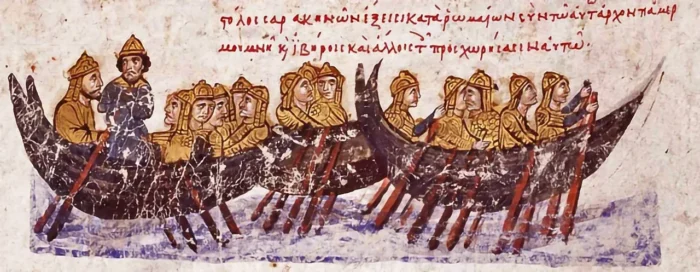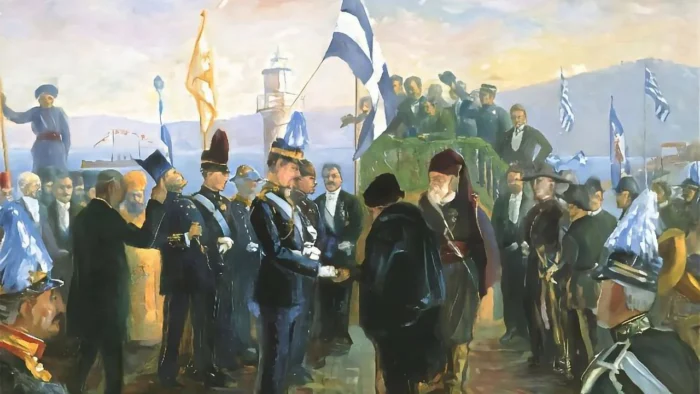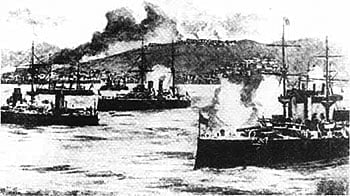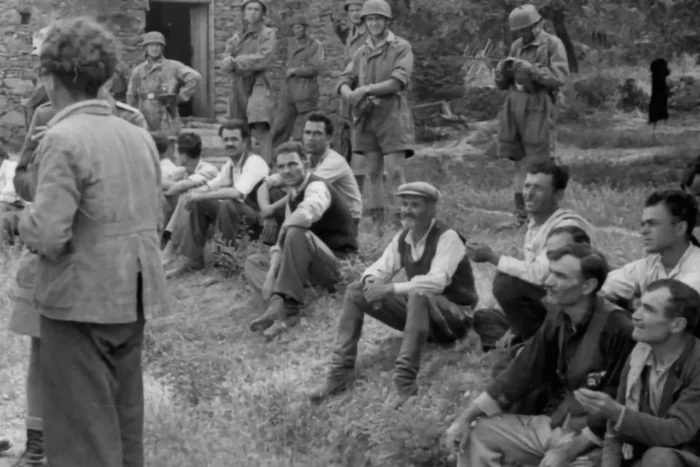Union of Crete with Greece – Part 1
December 1, 1913: Crete reunited with Greece
It was on a Sunday, the 1st of December, 1913 that the Greek flag was raised on top of the fortress of Firkas, on the western side of the harbour of Chania, in front of the King of Hellenes, Constantine, the Greek Prime Minister Eleftherios Venizelos and a tearful, emotional and enthusiastic crowd of proud Cretans. The struggle to reach to that moment had been a bloody and very long one. As the plaque at the location says:
TURKISH OCCUPATION OF CRETE
1669 – 1913
267 YEARS, 7 MONTHS, 7 DAYS
YEARS OF AGONY
Although the whole period was one of a difficult and often a bloody struggle, the last ninety years were the most difficult for all Cretans to bear because Greece, after enormous sacrifices, following the revolution of 1821, achieved independence from the Turkish yoke, but not Crete. Cretans had fought equally hard to overthrow the Turkish occupier, had made similar sacrifices, had shed in similar ways their blood for freedom, but the Great Powers had prevented Crete from joining Greece in becoming part of the new nation.
Independence for Greece but not for Crete
Greece was recognised as a new nation at the signing of the “Protocol of London” on the 22nd of January 1830 but Crete was left out of it. Crete was caught in the middle of power politics between the Great Powers who were circling the slowly dying Ottoman Empire and taking position to enable them to capture whatever they could. Crete was given to the Regent of Egypt to administer in recognition of services provided to the Sultan during the Greek revolution in Peloponnese.
The Egyptian administration lasted 10 years and it was a relatively quite period in comparison to the previous ten years. This was primarily due to the Egyptian ruler’s long term plan to achieve permanent control of the island and did not want to give any cause to the Great Powers to interfere with the affairs of the island during his administration period. In 1833 the island experienced an uprising but that was put down harshly and swiftly by the Egyptian troops by arresting and hanging the leaders of the uprising. The war between the Regent of Egypt and the Sultan in Syria in 1840 and the defeat of the Egyptians put an end to the Egyptian administration of Crete. The Great Powers convened again and still being in favour of keeping the Ottoman Empire intact they signed a new “Treaty of London” in July 1840 ceding Crete from Egyptian control and bringing it again under direct Turkish control.
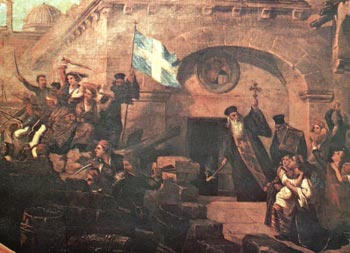
While that was happening a number of Cretan leaders who had been in exile in Greece, decided to return to Crete to organise a new uprising. This uprising was declared simultaneously in a number of places all over Crete on the 22nd of February 1841. Unfortunately this uprising did not last long as Crete was not prepared for an other long struggle, Greece was not in a position to help and the Great Powers were pressing for an end to the bloodshed. By April many of the surviving rebels left the island for the safety of Greece and an other long period in exile. A number of other uprisings were to follow with the biggest one being the 1866 – 1869 during which Crete experienced one of the bloodiest and harshest periods of repression. The holocaust of the Monastery of Arkadi was to become a legend and an example of the type of sacrifices that Cretans were prepared to make in their struggle for their freedom and for “Enosis”, union with Greece.
The Organic Act and the Halepa Agreement
The Sultan being urged by the Great Powers to bring an end to the carnage introduced a number of concessions under what became known as the “Organic Act” of 1868. The uprising continued and it was not until pressure from the Great Powers on Greece to stop providing assistance and supplies brought an end to it early in 1869.
Concessions earned following bitter struggle
The Turkish- Russian war that broke out in 1877 provided to the Cretans and the Greek government with a new opportunity for a new uprising that first started early in January 1878 in the west of Crete and soon spread to the rest of the island. The defeat of the Turkish army and the intervention of the Great Powers resulted in a new Treaty of San Stephano in February 1878 that imposed upon Turkey an obligation to comply with the provisions of the Organic Act. As for the Cretans, the Great Powers insisted on a cease-fire on the basis of further negotiations for a new treaty that was to take place a few months later in Berlin.
But unfortunately for the Cretans, no further gains came out of the Berlin conference. The Cretans continued with their struggle but shortages in ammunition and supplies prevented them from achieving any further gains. The Great Powers pushed for a resolution of the situation and the Turks agreed for the mediation of the British consul. In October 1878 a new agreement was reached between the leaders of the Cretan uprising and the Turks. This became known as the “Halepa Agreement” providing a new constitution for the island and made it a semi-autonomous province with specific privileges. These included a Christian Governor General, an elected Assembly with a guaranteed Christian majority, a Cretan gendarmerie, and other benefits including certain tax exemptions.
The next ten years were marred by internal political disputes that led to the elections of 1888 and electoral irregularities that further split apart the two main political parties. In May 1889 one of the parties tabled a motion in the Cretan Assembly calling for the union of Crete with Greece. This was an illegal move, forcing the dissolution of the Assembly, but its supporters fled to the mountains and declared a new uprising. The Turks with this opportunity declared martial law and installed as Governor General a Turk General and revoked the “Halepa Agreement”. Military courts, death penalties and mob violence were to follow, unmaking all the benefits that were achieved ten years earlier. The following five years represented one of the worst periods of Turkish rule on the island; Turkish terrorist groups roamed the countryside causing death and destruction, followed by Cretan rebels seeking revenge wherever they could get it. The intensification of the acts of violence all over the island prompted the Great Powers to step in and insist for the Sultan to provide a new constitution for the island. The terms of the new constitution were negotiated on the island with all the parties and a new agreement was reached that also contained all the benefits of the previous “Halepa Agreement”. Thus this uprising finished in August 1896. But not for long.
Events leading to the granting of autonomy to Crete
The Turks on the island were determined to undermine the new constitution and mob violence escalated against the Christians. A new Cretan gendarmerie was set up under the command of a British officer, Major Boor, but they were unable to control the massive violence that was aimed against the Christian population. The Greek government pressured by public opinion and not seeing any intervention coming from the Great Powers decided to send warships and personnel to assist the Cretan population. The Great Powers had no option then but to proceed with the occupation of the island, but they were somewhat late. A Greek army force of 1,500 men had landed at Kolymbari on 1 February 1897 and its commanding officer, colonel Timothy Vassos declared that he was taking over the island in the name of the King of the Hellenes and that he was announcing the union of Crete with Greece. This led to an uprising that spread throughout the island immediately. The Great Powers finally decided to land their troops and stoped Vassos from approaching Chania. At the same time their fleets blockaded Crete preventing both Greeks and Turks from bringing any more troops on the island. By March the island was partitioned into separate areas of control by troops from the Great Powers but this did not stop the fighting between Christians and Turks. What seemed as an unfortunate development for the Cretans, a new war had broken up between the Greek and the Turkish army in Thessaly, on the Greek mainland. This forced Greece to recall its troops from Crete to join the rest of the army on the mainland. The Turkish army was better prepared for this war and soon the Greek army was in retreat. The Great Powers again intervened and an armistice was signed on May 1897. According to the peace treaty signed on 4 December 1897, the Turkish army handed back Thessaly to Greece. But what was significant for Crete was that it gained autonomy, which in many Cretans mind was the first step towards union with Greece.
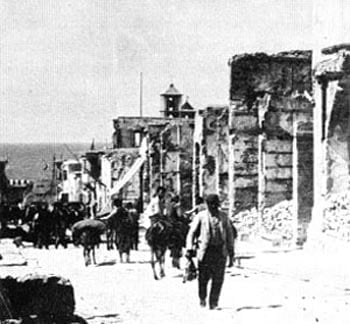
The offer for autonomy that was negotiated by the Great Powers was initially rejected by the Cretans who wanted union with Greece, but eventually, at a meeting of the General Assembly, on the 16 October 1897, they agreed to the autonomy option, as an interim solution. Negotiations between the interested parties on the selection of a suitable eminent person for the position of the High Commissioner went on for a while and eventually Britain and Russia convinced the Sultan to accept their nomination of Prince George, second son of the king of Hellenes for the position of High Commissioner.
The agreement provided that the High Commissioner would recognise the higher authority of the Sultan and would arrange for participation in the governing of the island by both Christian and Muslim Cretans. In the interim, until the High Commissioner was to take office, an Executive Council was formed with one of its six officers being Eleftherios Venizelos. Their task was to manage the administrative functions of governing the island together with the Council of the Commanders of the forces of the Great Powers, until the arrival of Prince George. Unfortunately the killings and massacres continued, the last and most tragic one took place at Heraklion on 25 August 1898. On that day while a British army detachment was leading certain officials to their accommodation at the tax office building, an angry Turkish mob attacked them, killing 17 British soldiers, the British Consul and some hundreds of Christians, setting fire and looting many stores. The British reacted immediately, arrested and hanged 17 of the ringleaders and arrested and jailed or sent to exile a large number of others. The British fleet under Admiral Noel sailed into Heraklion and demanded that all Turkish army, both from Heraklion and other parts of the island leave Crete immediately. On 2 November 1898 the last Turkish soldier left the island. A month later, on 9 December 1898 the High Commissioner, Prince George arrived at Souda bay.
Article by George Dalidakis: [email protected]
Read more: Union of Crete with Greece – Part 2
© explorecrete.com All Rights Reserved. Reproduction or copying without permission is prohibited.


